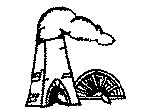
by Bob Krumm
 |
Waterpower Hike by Bob Krumm |
(An abridged version of this article appeared in the January, 2003, edition of Ironworkings.)
It was cold and rainy, and the trails were slippery, but it was the perfect day for a waterpower hike. On Sunday, November 17, 2002, former FOLPI president (and current Historic Preservation Specialist at Ringwood State Park) Martin Deeks led seven intrepid explorers on a FOLPI members tour along the Wanaque River to investigate the remains of a 19th century water power system.
The tour began with a short drive to the river's source, Greenwood Lake in Awosting. A thirty-foot puddle and a downed tree in the road prevented us from driving all the way to the dam, so we walked the remaining distance and were rewarded with a view of a thundering waterfall cascading over the dam. An adjustable overflow mechanism insures that water always flows into the Wanaque River below, no matter how low the lake's level.
Low water was not an issue this day. A storm the night before had transformed the normally brisk Wanaque River into a raging torrent. Back at the museum, we took off on foot upstream to a hill behind the two waterwheels. Here we saw a long narrow depression in the ground partly lined with stones. It was, we recognized, the remains of a raceway that once brought river water from the nearby falls to the two wheels.
Just to the side of this raceway there is a huge, rectangular, pit with hewn stone walls. This pit was built to hold a waterwheel twice the size of one of the two waterwheels below. With its axel on the wall, this wheel would have risen some 25 feet into the air. So massive would this wheel have been that it probably would have been constructed entirely of steel, Martin surmised. The collossal wheel was never actually built due to a downturn in the economy in the 1870's, but like the waterwheels below, it would have been an "overshot" wheel, meaning the water would come from above and drop over the wheel's upturned cups. We tried to imagine a raceway 25 feet above the already high spot on which we were standing. How would river water have fed a raceway this high? We set off into the woods to find out.
Martin led us on a newly bushwacked trail that ran along the remnants of the upper waterwheel's raceway. Not only were long sections of it still visible, but they were filled with rain water - giving us a hint of how it might have appeared had it ever actually been put to work. Further upland we came upon the remnants of an earthen dam and the suggestion of a long-ago pond above the dam. We saw a crevice in the dam that would have housed a large pipe to draw water into the raceway. A few yards downstream there were several stone buttresses perpendicular to the bank of the river. They were built to support the pipe at a level that would feed into the raceway.
We were now standing at an elevation that would have been level with the top of the colossal water wheel, had it been built. From this point, Wanaque River water would be diverted into man-made raceways, then flow downward to turn the giant wheel that would pump air into the furnace. We reflected on the tremendous effort that must have gone into the construction of this waterpower system - all for naught - except our modern day appreciation. We are lucky that so many components of the system are extant - affording us a fascinating glimpse into industrial hydropower of the 19th century.
FOLPI Information Line (973) 657-1688 or email us.
Calendar | News | History | Museum | Photo Gallery | Home | Panoramas | Get Involved | Contact | Links